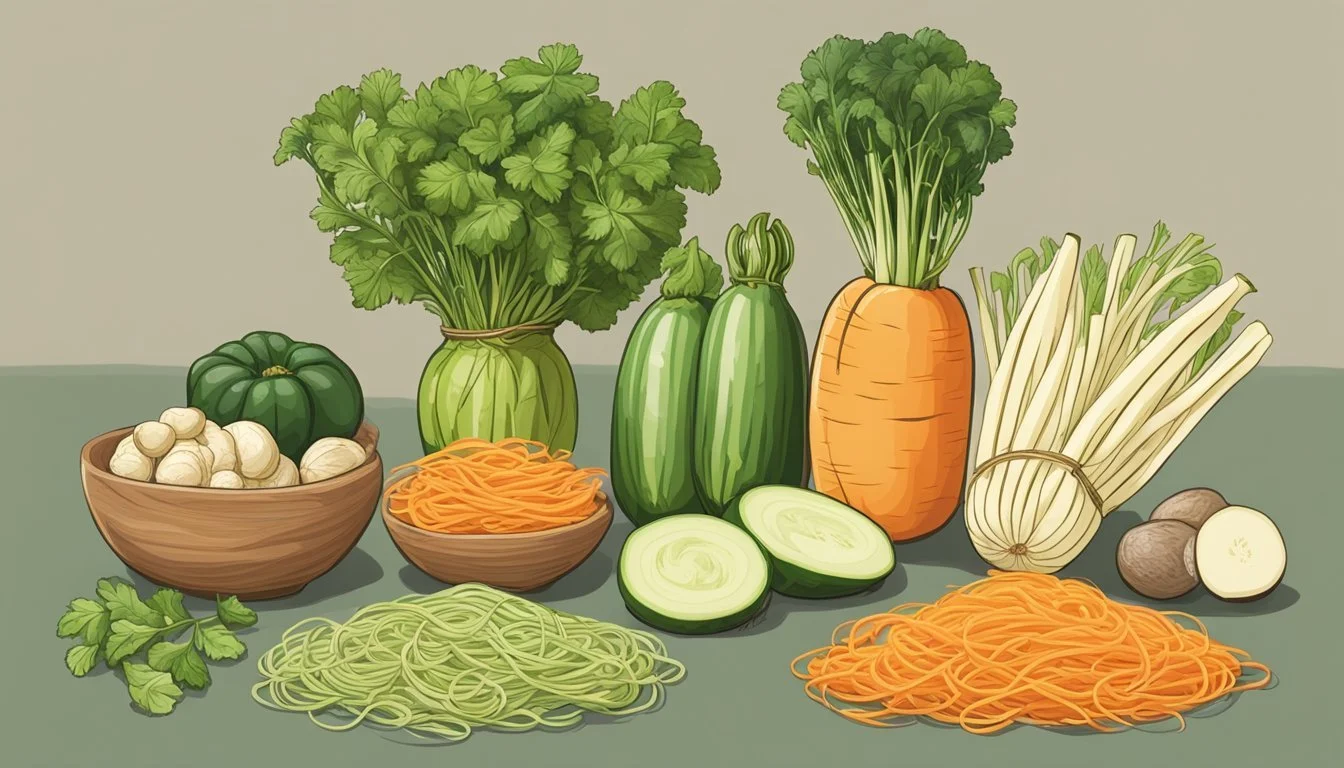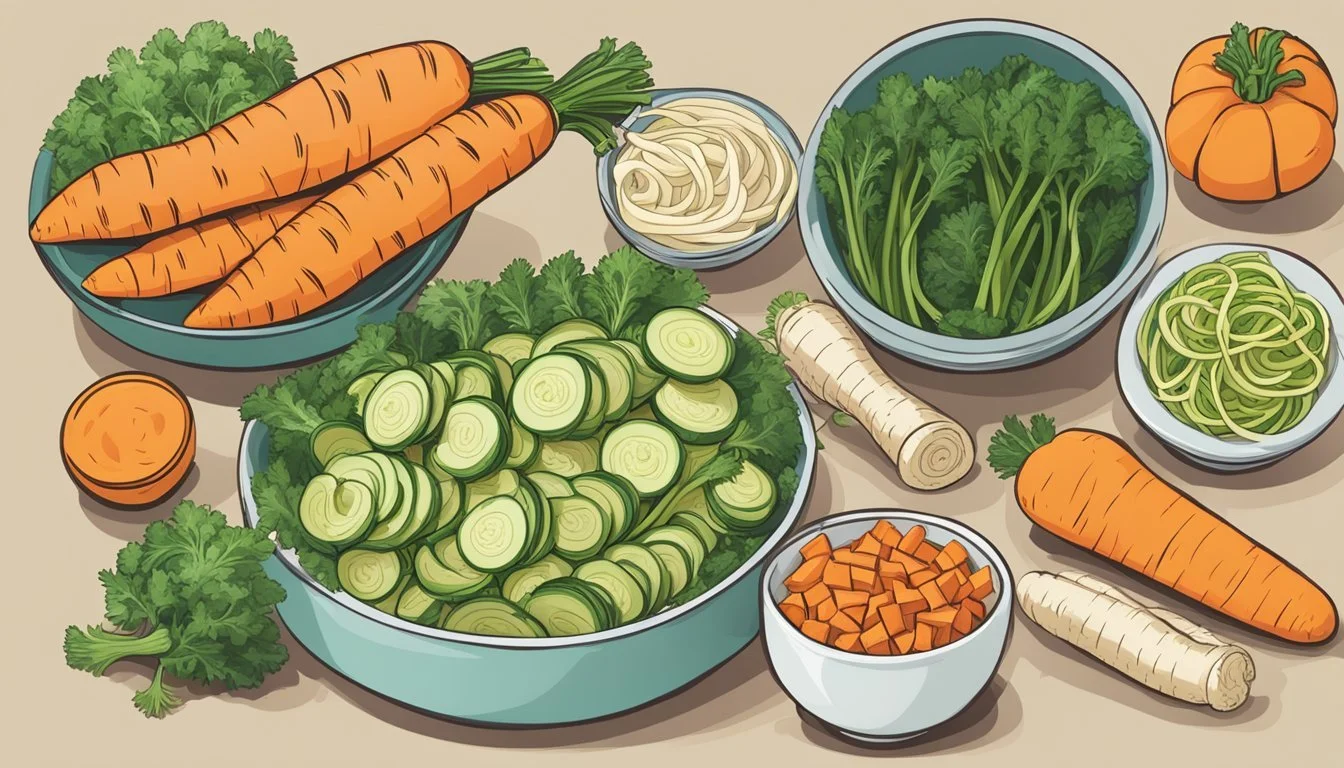Parsnip Noodle Substitutes
Top Alternatives for Healthy Eating
Parsnip noodles have become a favorite for those looking to incorporate more vegetables into their diet or seeking a healthier alternative to traditional pasta. Parsnips, a winter vegetable with a sweet, nutty flavor, make for a nutritious and flavorful base in noodle dishes. However, not everyone has access to parsnips year-round, and some may be looking to diversify their vegetable intake or to manage food intolerances. Finding a suitable substitute that maintains the textural integrity and complements the flavors of a dish is essential for anyone wanting to explore beyond parsnips.
Fortunately, there are several viable parsnip substitutes that fit a variety of culinary requirements and dietary preferences. Substitutes such as carrots, turnips, and salsify offer similar firmness and can be spiralized into noodle shapes just like parsnips. Carrots, a close relative of parsnips, provide a slightly sweeter taste and vibrant color, while turnips add a mildly spicy note. Salsify, often overlooked, brings an artichoke-like nuance to dishes. Each of these alternatives not only serves as a stand-in from a culinary standpoint but also aligns with the diet-conscious consumer's goal of maintaining a balanced and vegetable-rich diet.
Understanding Parsnips
Parsnips are a nutritious winter vegetable known for their unique flavor and versatility in the kitchen.
Nutritional Profile
Parsnips offer a range of health benefits due to their nutritious content. They are low in calories yet high in fiber, which aids in digestion and helps to maintain a healthy weight. In terms of vitamins and minerals, parsnips are a good source of vitamin C, vitamin K, and folate, as well as the minerals potassium and manganese.
Nutrient Amount per 100g Calories 75 kcal Fiber 4.9 g Vitamin C 17 mg Vitamin K 22.5 mcg Potassium 375 mg Manganese 0.3 mg
Culinary Uses
In culinary practices, parsnips are treated as a vegetable capable of being roasted, boiled, mashed, or used in stews and soups. Their shape and firmness make them ideal for creating parsnip noodles, offering a lower-carbohydrate alternative to traditional pasta. They can also be pureed for a smooth, creamy side dish or cut into chunks for a hearty addition to winter meals.
Flavor Characteristics
The flavor of parsnips is distinct, marked by a combination of sweetness and earthiness. This winter vegetable provides a subtle nutty taste, particularly when roasted, which brings out their natural sugars and highlights the complexity of their flavor profile. The taste is slightly similar to carrots, though with a deeper and sometimes spicier undertone.
Common Parsnip Substitutes
When searching for parsnip noodle substitutes, cooks may consider a variety of root and non-root vegetables that mimic the texture and flavor profile of parsnips. These alternatives offer culinary versatility and nutritional benefits.
Root Vegetables as Alternatives
Root vegetables provide a similar density and mouthfeel, making them excellent substitutes for parsnip noodles in recipes.
Carrots: They offer a slightly sweeter taste and come in various colors, including the classic orange and the paler white carrot, both of which require less cooking time.
Turnips: These have a sharper taste but become milder when cooked, suitable for stews and casseroles.
Rutabaga: A cross between a turnip and a wild cabbage, rutabaga brings a mild sweetness, ideal for roasting and mashing.
Sweet Potato: Though sweeter, sweet potatoes can stand in for parsnips in a pinch, especially in baked dishes.
Celeriac (Celery Root): Exhibiting a subtle celery-like flavor, celeriac can be used in purees or soup.
Salsify: Known in Europe, salsify can replicate the texture of parsnip noodles, with a flavor reminiscent of artichoke hearts.
Radish: Including daikon or red radishes, thinly sliced or spiraled, they can be a zesty raw alternative.
Kohlrabi: With its turnip-cabbage flavor, kohlrabi can be julienned for slaws or salads.
Non-Root Vegetable Options
For those seeking options outside of root vegetables, other vegetables can offer the required textural characteristics for noodle substitutes.
Jicama: This bulbous root provides crunchy and starchy qualities, adding a mild nuttiness to dishes.
Potato: A universal substitute, potatoes come in numerous varieties that can be spiralized for noodle-like presentations.
Each substitute brings its unique qualities to dishes, allowing for creative culinary adaptations that maintain the integrity of the original parsnip-based meals.
Specific Substitute Breakdown
When one seeks to replace parsnip noodles, a variety of root vegetables can offer similar textures and flavors. The following breakdown offers a focused look at specific alternatives.
Carrots and Carrot Varieties
Carrot: A staple in most kitchens, the orange carrot is a versatile substitute. It offers a slightly sweeter taste and needs less cooking time compared to parsnips.
Orange Carrots: They cook faster, so one should adjust the cooking time accordingly.
White Carrots: Closer in appearance to parsnips and can be used interchangeably in recipes.
Potatoes and Their Types
Classic Potatoes: A common substitute, providing a starchy texture that holds up well when spiralized for noodle-like strands.
Types:
Russet: Best for a firmer noodle.
Yukon Gold: Creamier texture, slightly sweet.
Celery Root (Celeriac): Best mimics the earthiness of parsnips and can be prepared in the same manner as potatoes for noodle substitute.
Turnips and Rutabagas
Turnips: Offer a slightly spicy but still earthy component that can add an interesting twist to dishes. Rutabaga: A hybrid of a turnip and a cabbage, slightly sweet, perfect for mashes or stews.
Exotic Alternatives
Parsley Root: Similar in look and feel to parsnips, though a little less earthy. Arracacha (also known as Peruvian Parsnip): A South American root that has a similar flavor profile to parsnips, making it an excellent choice for more exotic dishes.
Cooking Techniques for Substitutes
When adapting recipes to include parsnip noodle substitutes, chefs should consider how different cooking methods affect the alternatives' textures and flavors. The right technique can enhance the natural sweetness and desired consistency of root vegetables that stand in for parsnip noodles.
Roasting Substitutes
Vegetables: Carrots, Sweet Potatoes
Temperature: 425°F (220°C)
Timing: 20-25 minutes
To replicate parsnip's roasty sweetness in noodles, thinly slice or spiralize carrots or sweet potatoes. Toss them with oil, season, and roast in a preheated oven. Their natural sugars will caramelize, providing a familiar flavor profile.
Mashing Techniques
Vegetables: Rutabaga, Celery Root
Consistency: Creamy, not gluey
Add-ins: Butter, Cream, Seasoning
One can achieve a similar texture to mashed parsnips by boiling and mashing rutabaga or celery root. For creaminess, add butter and a touch of cream. Season well to bring out their earthy, rich flavors.
Baking and Frying Alternatives
Vegetables: Turnips, Parsley Root
Preparation: Batter, Bread Crumbs
Cook: Until golden brown
Baking or frying alternatives like turnips or parsley roots provide a crunchy exterior and tender inside. They work well when cut into the shape of noodles, breaded, and either baked until crispy or fried to a golden brown.
Purees and Soups
Vegetables: Salsify, Carrots
Texture: Smooth puree
Soup Base: Vegetable or Chicken Broth
Salsify and carrots pureed into soups deliver an exquisite, velvety mouthfeel. A base of vegetable or chicken broth ensures a flavorful soup that complements the subtle sweetness of the chosen substitute.
Considerations When Choosing Substitutes
When selecting an alternative for parsnip noodles, it's crucial to consider how the substitute will interact with the flavors and textures of the dish. The aim is to find a balance that closely mimics the original ingredient while adhering to any dietary restrictions.
Flavor Pairing and Balance
Flavor: Parsnips have a sweet and slightly nutty flavor that can be replaced by similar root vegetables. Some appropriate substitutes include carrots and turnips, which offer a comparable sweetness, though it should be noted that turnips may introduce a slightly spicier note. Other substitutions like celery root bring an earthy taste that pairs well with hearty dishes.
Aroma: The distinct aroma of parsnips plays a significant role in the overall taste. Substitutes should be selected that complement other ingredients without overshadowing them.
Texture and Consistency
Texture: The ideal substitute should mimic the firmness of cooked parsnip noodles to maintain the expected mouthfeel. White carrots match the texture closely, keeping the structure similar.
Consistency: Cream-colored root vegetables like salsify can be a good match for consistency. They should be prepared in a manner that achieves a similar al dente quality.
Dietary Restrictions
Diet: For those with dietary concerns, it is important to consider the sugar content and the possibility of allergens. Turnips, for instance, are lower in sugar compared to parsnips, making them a suitable option for diabetics.
Substitute: The chosen substitute must align with the individual's nutritional needs, whether they are following a low-carb, gluten-free, or vegan diet. Radishes can serve as a parsnip substitute for low-carb diets.
Recipes and Serving Ideas
When seeking substitutes for parsnip noodles, one becomes privy to a delightful range of alternatives suitable for side dishes, main courses, and unique presentations. Each substitute contributes a distinct flavor profile and texture, ensuring that any dish retains its comforting essence.
Side Dishes with Substitutes
For side dishes, the ideal parsnip noodle substitute is often parsley roots, which are slim and can be cut into noodle shapes very similar to parsnips. They can seamlessly replace parsnip in:
Roasted Vegetable Medleys: Toss parsley root noodles with olive oil and herbs, and roast until tender.
Glazed Roots: A honey glaze complements the parsley root noodles well, offering a comforting and sweet twist.
Main Courses
Main courses demand a substitute that can hold up to robust flavors and longer cooking times. Some options include:
Carrot Noodles: Carrots, cut into noodles, can serve as a hearty base for stews or braised dishes.
Sweet Potato Noodles: Sweet potatoes spiralized into noodles provide a naturally sweet foundation for heavier sauces.
Innovative Serving Suggestions
Innovative presentations of these substitutes can elevate the dining experience:
Noodle Bowls: Use sweet potato or carrot noodles as the base for a veggie-packed bowl topped with protein and dressing.
Stir-Fries: Quickly sauté carrot noodles with a mix of vegetables and your choice of protein for a healthy twist on traditional stir-fry.






